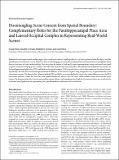Disentangling Scene Content from Spatial Boundary: Complementary Roles for the Parahippocampal Place Area and Lateral Occipital Complex in Representing Real-World Scenes
Author(s)
Park, Soojin; Brady, Timothy F.; Greene, Michelle R.; Oliva, Aude
DownloadOliva-20110Disentangling.pdf (1.697Mb)
PUBLISHER_POLICY
Publisher Policy
Article is made available in accordance with the publisher's policy and may be subject to US copyright law. Please refer to the publisher's site for terms of use.
Terms of use
Metadata
Show full item recordAbstract
Behavioral and computational studies suggest that visual scene analysis rapidly produces a rich description of both the objects and the spatial layout of surfaces in a scene. However, there is still a large gap in our understanding of how the human brain accomplishes these diverse functions of scene understanding. Here we probe the nature of real-world scene representations using multivoxel functional magnetic resonance imaging pattern analysis. We show that natural scenes are analyzed in a distributed and complementary manner by the parahippocampal place area (PPA) and the lateral occipital complex (LOC) in particular, as well as other regions in the ventral stream. Specifically, we study the classification performance of different scene-selective regions using images that vary in spatial boundary and naturalness content. We discover that, whereas both the PPA and LOC can accurately classify scenes, they make different errors: the PPA more often confuses scenes that have the same spatial boundaries, whereas the LOC more often confuses scenes that have the same content. By demonstrating that visual scene analysis recruits distinct and complementary high-level representations, our results testify to distinct neural pathways for representing the spatial boundaries and content of a visual scene.
Date issued
2011-01Department
Massachusetts Institute of Technology. Department of Brain and Cognitive SciencesJournal
Journal of Neuroscience
Publisher
Society for Neuroscience
Citation
Park, S. et al. “Disentangling Scene Content from Spatial Boundary: Complementary Roles for the Parahippocampal Place Area and Lateral Occipital Complex in Representing Real-World Scenes.” Journal of Neuroscience 31.4 (2011): 1333–1340. Web.
Version: Final published version
ISSN
0270-6474
1529-2401